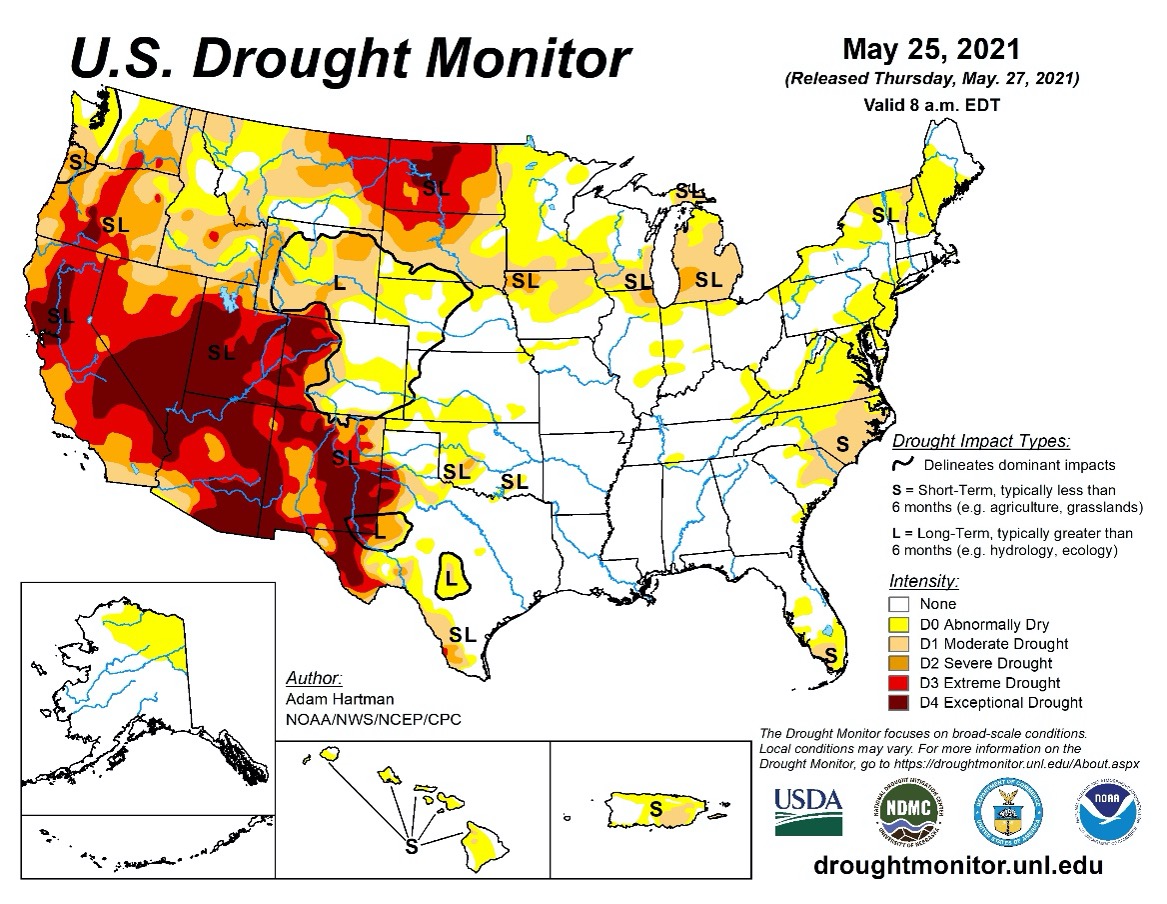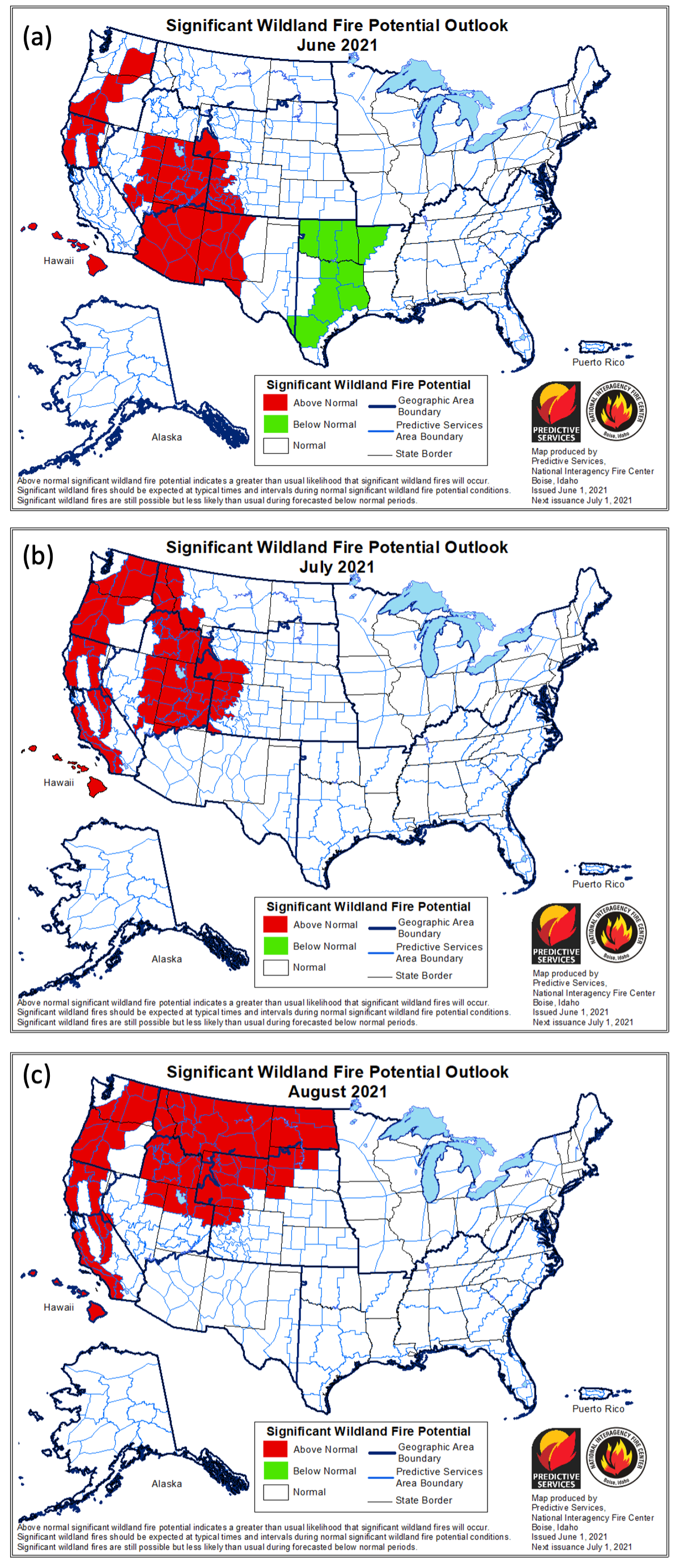The record-breaking wildfire season of 2020 is still fresh in the memories of the residents of California and other Western U.S. states. Early season wildfires, such as the Palisades Fire that burned over 1,200 acres and threatened homes in Los Angeles County in mid-May 2021, serve as a stark reminder of the danger that wildfires pose during periods of extreme aridity, even well outside of the traditional fire season.
California and indeed much of the West remain in a prolonged and extreme drought that began a year ago and is showing no sign of abatement. The current U.S. Drought Monitor, a multi-agency product that represents a synthesis of several measures of drought intensity, shows almost the entire Western United States suffering from some degree of drought (Figure 1).

Specifically, 88% of the land area of the Western states is currently in drought conditions, while more than 50% is in either Extreme (D3) or Exceptional (D4) Drought; in California, 75% of the state’s land area is in either Extreme (D3) or Exceptional (D4) Drought. Given that just prior to 2020’s devastating fire season only 2% of the Western United States—and 3% of California—were in Extreme (D3) or Exceptional (D4) Drought in June, the situation this year is alarming.
Hot and Dry
The drought forecast for the coming months is ominous. The National Weather Service Climate Prediction Center’s 1-month and 3-month climate outlooks indicate a high probability that temperatures will be above normal throughout the entire Western United States, most notably in the Southwest, and that precipitation will be below normal in the Pacific Northwest and the Rocky Mountains. Thus, drought is expected to persist in California and the Southwest, where the climatology is relatively dry throughout the outlook period, and to intensify in the Northwest in areas that are not already experiencing drought. With vegetation already stressed in many parts of the region, and lower than average measured fuel moistures due to the extended drought, the potential for wildfire could increase dramatically during the coming months.
Nevertheless, the relationship between drought and wildfire is often more complex than expected. While long-term extreme drought typically increases fire danger in forested regions, where typically there is an abundance of fine fuels in the forest canopy and often on the forest floor, an extended drought can limit the growth of vegetation in grassland or other herbaceous systems during the growing season. This results in lower fuel loads and potentially reduced fire danger in such grasslands and mixed fuel regimes.
Increased Wildfire Activity
Given the dire situation regarding drought and fuel moisture, however, it is not at all surprising that the outlook for the coming months is for increased wildfire activity across much of the Western United States.

The Significant Wildland Fire Potential Outlook provided by the National Interagency Fire Center (Figure 2) projects above-normal fire activity in June throughout a swath that includes the Southwest (i.e., Arizona and New Mexico), eastern Nevada, Utah, and western Colorado, and a separate zone in northern California and parts of the Pacific Northwest. The latter zone of above-normal fire activity extends into Southern California and more of the Northwest through July and August. The projected return to normal fire activity in the Southwest in July and August is associated with the arrival of the Southwest Monsoon, although the timing and intensity of rainfall with the monsoon can be variable and the fire outlook may change if the actual precipitation deviates significantly from normal.
Some areas in the Western United States are already seeing above-normal fire activity. Perhaps most disturbing in this regard is that CAL FIRE is reporting a total of 12,083 acres burned on state and local land through May 31, 2021, almost 50% above the 5-year average of 8,600 acres and dramatically greater than the total of 2,828 acres burned during the same period last year.
Uncertain Outcome
While the current conditions set the stage for another active fire season in 2021, that doesn’t necessarily mean that this year’s season will be as bad or worse than 2020. Drought is only one component of wildfire risk; sources of ignition are critical, as is the weather at the time of an ignition. Overall fire activity is a result of the complex interplay between many elements of vegetation, weather, and human activities. The 2020 wildfire season in California in particular saw unusually large amounts of dry lightning in August that ignited hundreds of fires. In the case of the August Complex fire in Northern California, 37 of those lightning-caused fires merged into a single wildfire exceeding 1 million acres, known as a gigafire, the largest fire complex in California since reliable recordkeeping began in 1932.
Regardless of whether the 2021 wildfire season turns out to be more active than normal or otherwise, property owners in the wildland-urban interface should always take steps to prepare for the coming fire season by maintaining adequate defensible space around their homes and businesses and by removing dead vegetation and debris that could potentially ignite and spread to nearby structures. Mitigating wildfire risk encompasses a range of strategies at both the property and community levels, but putting them into practice can present challenges in terms of feasibility and engagement. Verisk devotes extensive study and support to multiple aspects of mitigation.
Understand and manage your fire risk with Verisk wildfire solutions

